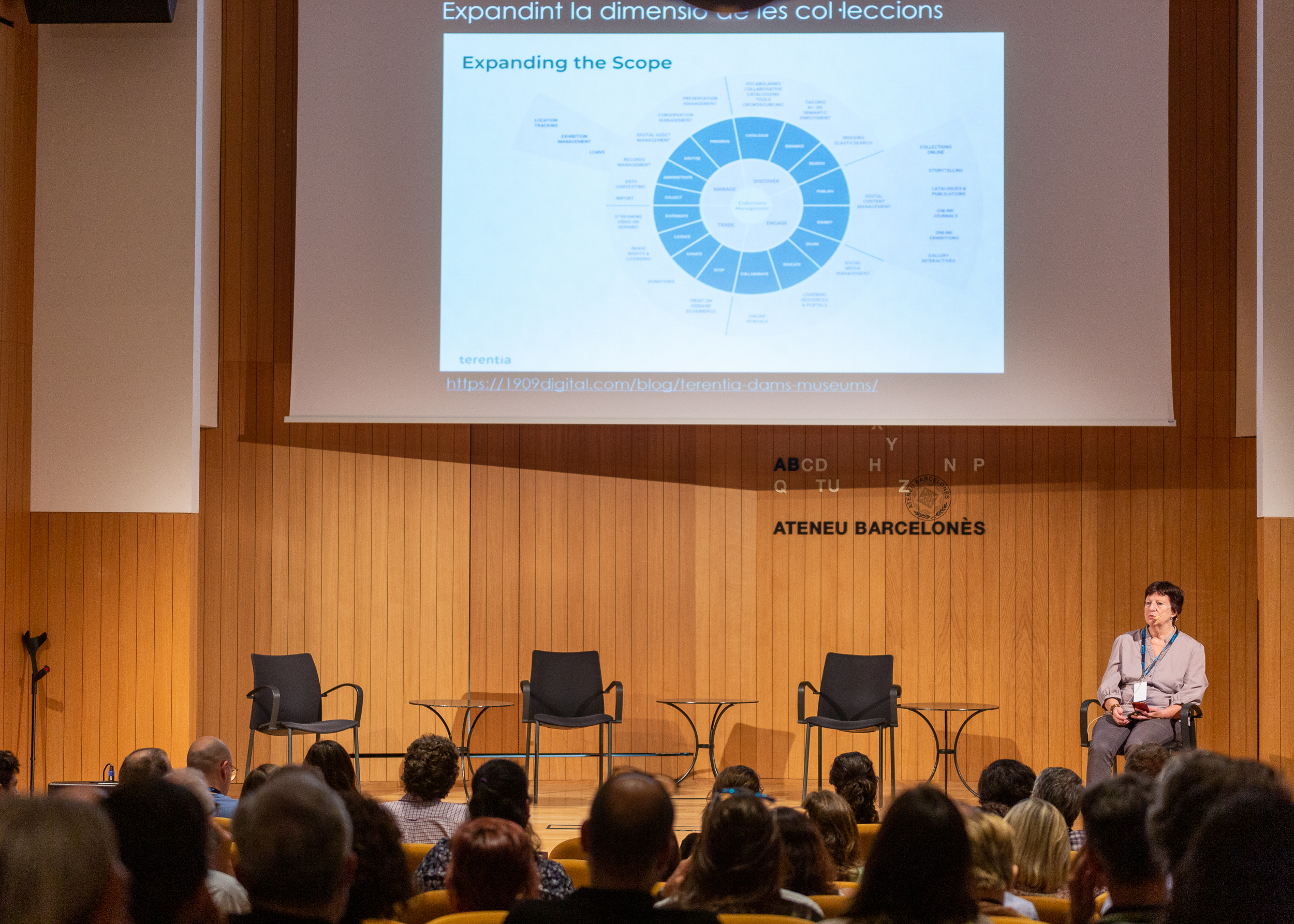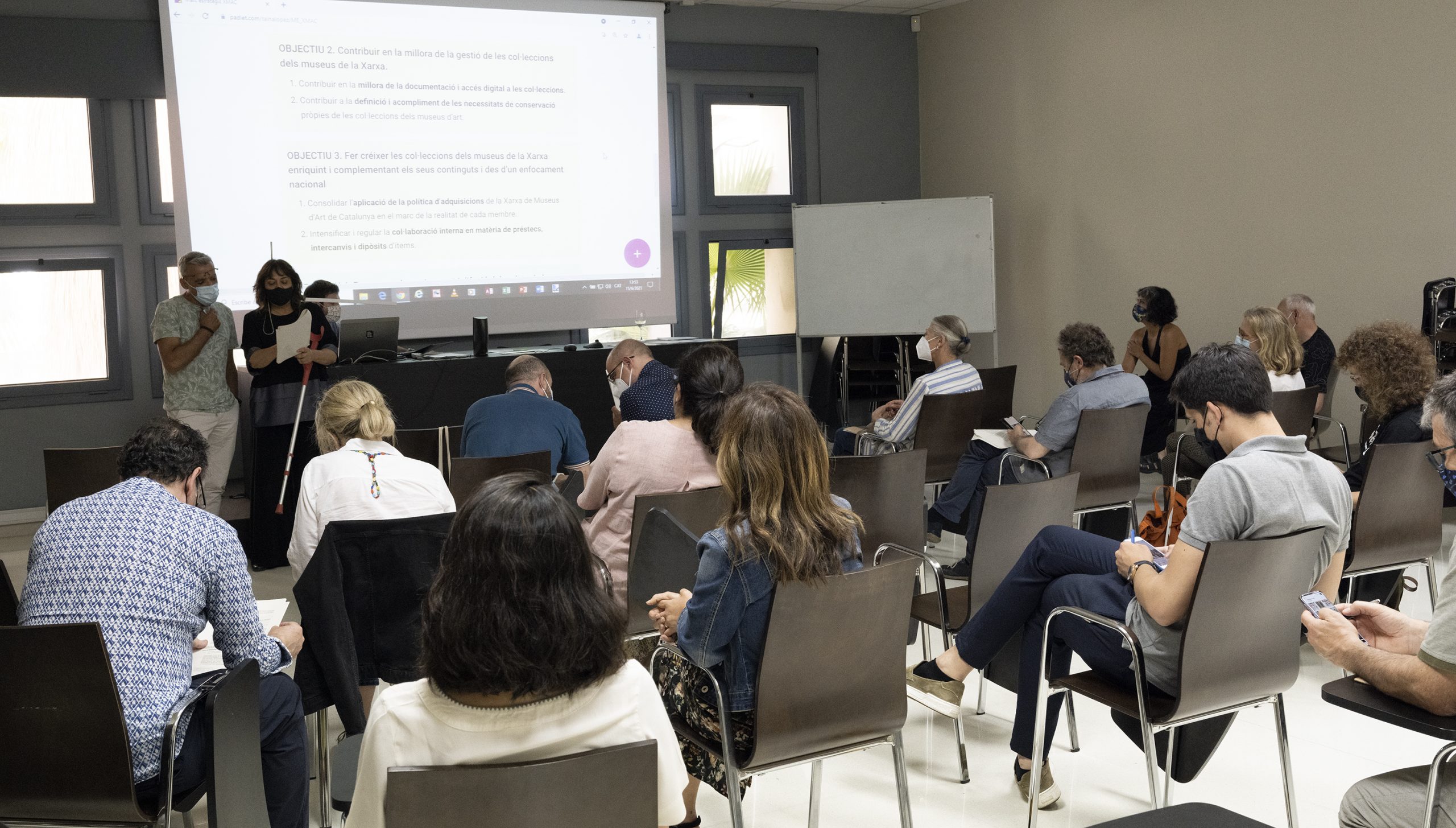Conxa Rodà
This post is a version of the talk given within the framework of the #JornadaCoeli22 held in the Ateneu Barcelonès on 2nd June.
Humans have had collaborative DNA since prehistoric times: to hunt mammoths, to survive, men did so in groups. Today, in order to carry out our projects successfully, we need to work collaboratively, as a team.
In Museums there is a good tradition of collaborative work, especially for temporary exhibitions or the creation of collective catalogues.

Talk “The collaborative DNA of Museums” in Jornada Coeli 2022, hosted by Ateneu Barcelonès (2/6/22). ©Catherine Gómez
In the digital context, and as the pandemic has shown, collaboration has become more necessary than ever. Digital projects require fluid workflows and processes that represent a challenge for traditional hierarchies, meaning that teams have to collaborate across different departments.
Why collaborate? Because by collaborating we can do more and better. Multidisciplinary teams bring richness to projects. By collaborating we go further (and so do our collections). We are in the age of Co-: cooperate, collaborate, coordinate, co-organise, co-produce, co-create, co-manage. Knowledge is said to be the most valuable intangible, as such it needs to be shared so that it multiplies.
In a digital environment, how do we define collaboration? From the Digital Administration of the Generalitat of Catalonia they define it as such: “It is the dimension that addresses the ability to work in a team and in a collaborative way by generating synergies between people and taking advantage of the options offered by technologies”. Digital transformation requires cross-cutting collaboration. Because it affects the WHOLE museum, everyone must participate and contribute.
Among the skills needed in the 21st century, among the so-called soft skills, collaboration is one of those highlighted. Ngaire Blankenberg, now director of one of the Smithsonian’s museums, the National Museum of African Art, states in the Manual of Digital Planning: “New skills in the digital age for all museum workers include communication and visual literacy, collaboration, agility and experimentation, problem solving, and knowledge sharing”.
The European Commission also highlights the importance of collaboration, among other skills, in building the digital future.
In addition to these conceptual arguments, in practice, the ability to collaborate is already a requirement in many museum job offers, especially in the Anglo-Saxon world.
Regarding museum collections, they represent a dimension that transcends many boundaries and areas. We can establish multiple connections between different fields of knowledge and expertise based around the management of collections. Digital content, for example, covers online collections, catalogues and publications, virtual exhibitions, interactive museography in galleries, storytelling, etc. For all this, in order to build good narratives, collaboration is needed between the experts in the field of the museum – conservation, restoration, documentation, and research; and the experts in transmitting knowledge and building storytelling for multiple audiences – education, communication, marketing, and digital staff. This cross-cutting collaboration will result not only in a better way of working but, above all, in a better service to our visitors and users.
But collaborating, as we all know, is not always easy. So if it’s so important and recognized, why is it so hard to collaborate? For sure, there are multiple reasons, I think the three main ones are attitude – closed mindedness, the lack of leadership and transparency and the lack of suitable tools. The results of a survey I did on LinkedIn in Catalan and on Twitter in English both coincide. The main reason is attitude, closed mindedness. Internal resistance, organizational culture is often the factor that slows down change, transformation (digital or not).
To be able to work well in collaboration, there are some conditions, some requirements. Some are of a personal nature, of the attitude of the people, others are of an organizational nature:
- in the first place it is essential that there is a very clear common goal for all members of the team, of the working group
- there have to be rules of the game based on transparency and fluid communication
- team members also need to have an open, flexible attitude to changes that may occur, being willing to experiment, and to learn
- the relationship must be based on trust and mutual respect. They do not need to be “best friends”, they need to be able to put the collective interest first and work together, contributing the best qualities and skills
- involvement and commitment are required
- the more diverse the team, with multiple capabilities, the richer the collective construction of knowledge
- it is necessary, of course, to have the appropriate tools, i.e. the suitable technological infrastructure, collaborative tools, training
- all in all, enabled, driven by good leadership.

Lecture at Jornada Coeli 22: https://www.museunacional.cat/pdf/JornadaCoeli22.pdf
Let’s look at three international examples of good internal collaboration.
At the Rijksmuseum, they created 4 Agile working groups. Exhibitions, personal stories, Visitor Journey and digital innovation. The then director Taco Dibbits explained in an interview that after a while they decided to open these groups to the whole museum so that everyone could participate and this empowered the teams and enriched the diversity of perspectives to face complex problems.
At the Tate, some years ago now, they produced an experience of virtual reality recreating the studio of Modigiliani. In the video it is interesting to hear the contributions of the different participants in the project and how the conservator highlighted this transversal work.
And the third example comes from the strategic plan 2020-2030 of the Science Museum Group, of the United Kingdom, which has established collaboration as one of their four strategic priorities. They are committed to working collaboratively, internally and externally, and in addition to this statement of principles, they specify what they will do: for example, to share research-based good practice frameworks. A good exercise in transparency.

Strategic plan 2020-2030 from the Science Museum Group of the United Kingdom
Here, in Catalonia, we also have very good examples, allow me to highlight two in which the Museu Nacional d’Art de Catalunya has worked on: the Mapping of Taüll, winner of a Museums and the Web award, or more recently the project Engagementwhich you can already experience in the Romanesque rooms and on the website. Both projects have required intense internal and external cooperation with universities, technology companies and other administrations.
Regarding collaboration between museums in Catalonia, two good examples, in which the Museu Nacional also takes part: the Network of Art Museums and the digital analytical project, led by the Observatory of audiences of Cultural Heritage of Catalonia, in which more than 20 Catalan museums have agreed on a common series of indicators and share them to be processed by the Observatory.os comparten para que los procese el Observatorio.
Now is the time for alliances, more than ever. Museums have long been open to external collaboration. There are many options:
- other museums (local, international)
- artistic, historic, scientific, educational environment
- universities
- cultural and social organisations
- community
- technological companies
- start-ups
- digital experts

Work session of Xarxa de Museus d’Art de Catalunya. ©Marc Vidal
Collaborating makes us stronger. By collaborating we go further, and so do our collections.
Do you find it difficult to collaborate? Want to share a collaborative project from your museum or one you know? Please, leave a comment below.
Conxa Rodà
Recommended links
La II Jornada Coeli, tot un èxit #JornadaCoeli22
Collaboration challenge for 2022—be intentional, transparent, and creative, Stephanie Spangler
What does successful digital collaboration look like, Digileaders
If we’re all so busy, why isn’t anything getting done?, McKinsey
Making Sense of Work Through Collaborative Storytelling, Tricia Cleland, Paulo de Tarso
Co-directora del Curs d'Estratègia Digital_UOC_Museu Nacional d'Art de Catalunya
Co-directora del congrés CIMED de Museos y Estrategias Digitales







